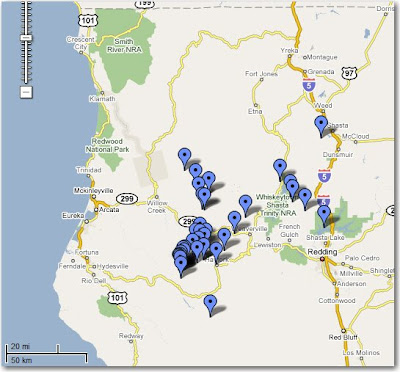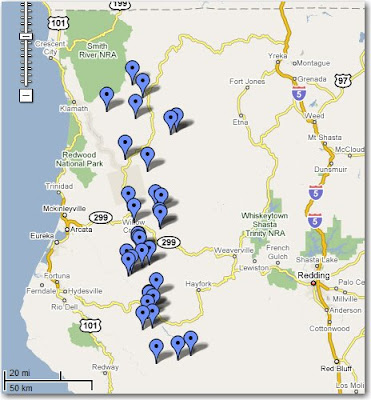 A fire in the Peanut area of Trinity County, south of Hayfork, CA. Timbre Beck-Murphy/Contributing photogrpaher, Redding.com
A fire in the Peanut area of Trinity County, south of Hayfork, CA. Timbre Beck-Murphy/Contributing photogrpaher, Redding.comThe Record Searchlight newspaper in Redding, California has an update about the lightning-caused fires in the Shasta-Trinity National Forest. Here is an excerpt:
By Constance Dillon, Rob Rogers
Sunday, June 22, 2008Widespread thunderstorms rolling through the north state late Friday night and Saturday ignited scores of fires ranging in size from less than an acre to hundreds of acres in lightning-torn Trinity County.
The largest concentration of fires is known as the Lime Complex near Limedyke Mountain in the Hayfork Ranger District of the Shasta-Trinity National Forest, forest spokesman Mike Odle said. The Lime Complex in Trinity County includes 30 fires burning more than 1,000 acres, Odle said.
Another large complex of fires is called the Iron Complex in the Big Bar Ranger District near Junction City off Highway 299. Multiple fires are burning 350 acres in the Iron Complex, Odle said.
Some 3,000 lightning strikes spawned 75 fires in the Shasta-Trinity National Forest from Friday night to Saturday afternoon, and fire officials were bracing for more thunderstorms Saturday night, Odle said. Forest Service officials still were assessing the fires’ acreage Saturday afternoon.
Smoke first was reported Friday afternoon in the Hyampom Road area of Trinity County. By 3 a.m. Saturday, Forest Service crews started dispatching fire crews, engines, bulldozers and water tenders.
“We were told to expect 50 to 100 fires,” said Angelo Cattaneo, owner-operator of Cattaneo Trucking, as she stood in front of a row of water trucks and engines outside the Hayfork Ranger District on Saturday.
More than 20 smokejumpers were sent to fires in the more remote regions.
Fire crew leaders radioing the Hayfork Ranger District office with reports of small fires Saturday were interrupted by frantic reports of new flare-ups. “This whole place is on fire,” one Forest Service worker’s voice said over the fire scanner. Another voice cut in: “This place is too tight for my guys to rappel in.”






 Any other situations where you tempted fate?
Any other situations where you tempted fate?
